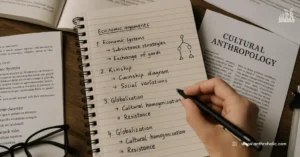AI Answer Evaluation Platform Live Now. Try Free Answer Evaluation Now
Marriage and Family
Marriage and Family are fundamental social institutions that have been evolving over time. As sociologist William J. Goode once said, “The family is not a static institution, but one whose internal and external structures have been and are still changing”. With changing gender roles, economic pressures, and technological advancements, the nature of marriage and family has undergone significant transformation. What does this mean for the future of these institutions? Will traditional notions of marriage and family continue to prevail, or will we see a shift towards more non-traditional forms? How will these changes impact our understanding of family and its role in society? This essay aims to explore these questions and more, as we delve into the complex world of marriage and family in modern society.

The changing definition of marriage
Marriage has undergone significant changes in its definition over the years. In the past, marriage was largely viewed as an economic or political alliance between families, designed to secure property or social status. Over time, the concept of marriage shifted to focus on romantic love and companionship. More recently, there has been a growing recognition of the rights of same-sex couples to marry, challenging traditional notions of gender roles and sexual orientation. Additionally, there has been a rise in non-traditional forms of marriage, such as polygamy or open marriages. These changes reflect the evolving values and beliefs of society, and have significant implications for the legal, social, and cultural dimensions of marriage.
Family structures
(These are just a few examples of the diverse family structures that exist in modern society. Each structure has its own unique challenges and opportunities, and it is important to understand and appreciate the complexities of each one)
Family structures refer to the different ways that families are organized and composed. The most common family structure is the nuclear family, consisting of a married couple and their biological or adopted children. Other family structures include extended families, where multiple generations live together, and single-parent families, where one parent raises the children. Blended families result from remarriage or cohabitation, combining children from previous relationships. In recent years, there has been an increase in non-traditional family structures, such as same-sex couples with children or co-parenting arrangements. Understanding the diversity of family structures is essential in order to appreciate the complexities of modern family life and to develop policies that support family well-being.
Parenting
Parenting is the process of raising and nurturing a child from infancy to adulthood. It involves providing physical, emotional, and intellectual support to help the child develop into a well-adjusted and responsible adult. Effective parenting includes setting boundaries, being responsive to the child’s needs, and fostering a positive relationship with the child. Parenting styles can vary widely, from authoritarian to permissive, and can have a significant impact on the child’s development and future success.
Family traditions and rituals
Family traditions and rituals are important in creating a sense of identity, belonging, and continuity within a family. Traditions can include religious or cultural practices, such as celebrating holidays or attending religious services, while rituals can involve regular family activities, such as family dinners or game nights. These traditions and rituals provide opportunities for family members to connect, share experiences, and create memories together. They also serve to reinforce family values and provide a sense of stability and predictability, which can be particularly important during times of change or uncertainty. Overall, family traditions and rituals play an important role in maintaining strong family relationships and creating a sense of shared history and culture.
Challenges to Marriage and Family
Sociology identifies several challenges to marriage and family. Firstly, changing gender roles have led to a decline in traditional family structures, with fewer households consisting of a male breadwinner and a female homemaker. Secondly, the rise of individualism has led to an increased focus on personal fulfillment, which can create tension within relationships. Thirdly, economic and social inequalities can put stress on families, particularly those in poverty. Fourthly, advancements in technology have made it easier to connect with others outside of the family unit, which can lead to infidelity and relationship breakdown. Lastly, increasing rates of divorce and non-traditional family structures have led to a redefinition of what constitutes a “family”.
Impact of Technology
Technology has had a significant impact on marriage and family life. On one hand, it has made communication easier, allowing family members to stay in touch regardless of distance. It has also made household tasks more efficient, allowing for more time together as a family. However, technology can also lead to negative consequences, such as increased screen time and decreased face-to-face interaction. Social media can also lead to infidelity and cyberbullying. Technology can also contribute to the blurring of work and home life, making it difficult to establish healthy boundaries. Overall, technology has both positive and negative impacts on marriage and family, and it is important for individuals to use it in a way that supports healthy relationships.
Marriage and Family in the Global Context
Marriage and family look different in various global contexts. In some cultures, arranged marriages are common, while in others, individuals choose their partners independently. The definition of family also varies, with some cultures emphasizing extended family relationships over nuclear family structures. Economic and social factors also play a role in shaping marriage and family, with poverty and inequality affecting family stability in many parts of the world. Additionally, gender roles and expectations can differ greatly between cultures, impacting the dynamics of marriage and family relationships. Overall, understanding the diversity of marriage and family across global contexts is essential to effectively navigate cross-cultural interactions and promote cultural sensitivity.
Conclusion
In conclusion, marriage and family are complex and dynamic institutions that have evolved over time in response to changes in society. While traditional notions of marriage and family still persist, there has been a growing recognition of the diversity of family structures and relationships. This diversity reflects the changing values and beliefs of society, and presents both opportunities and challenges for individuals and families. Despite these changes, the importance of strong family relationships and supportive marriages remains constant. Ultimately, it is up to each individual and family to navigate the complexities of modern marriage and family, while embracing the values and traditions that are meaningful to them.




